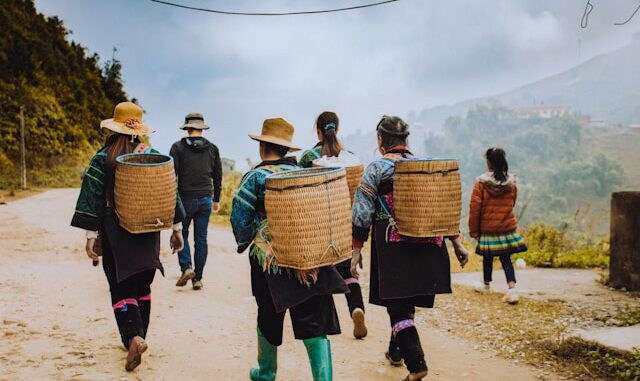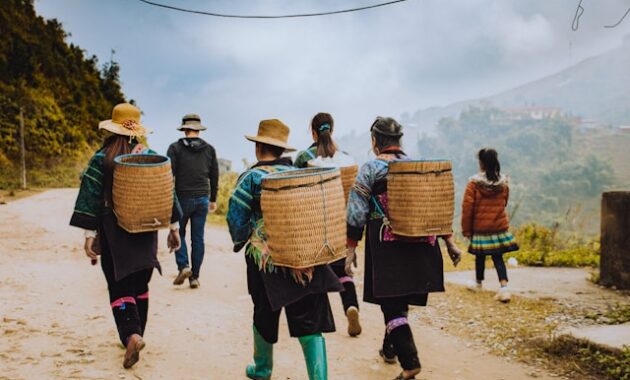
Vietnam’s rich cultural heritage is beautifully showcased in its traditional homestays, offering travelers an intimate glimpse into the country’s rural life. Among the most captivating destinations to experience such homestays are Sa Paand Ha Long, two locations that embody the diversity, beauty, and welcoming spirit of the Vietnamese people. These homestays allow visitors to connect deeply with the local communities, immerse in indigenous traditions, and explore the pristine landscapes of northern Vietnam. In this article, we will explore the enchanting world of traditional Vietnamese homestays, focusing specifically on the distinctive experiences found in Sa Pa and Ha Long Bay.
What Are Traditional Vietnamese Homestays?
Traditional Vietnamese homestays are not simply places to stay during your travels; they are cultural exchanges that invite you into the homes of local families. These stays typically occur in rural or mountainous areas, where families still maintain their ancestral ways of life. Visitors are not merely guests but become participants in the daily routines of their hosts, from communal meals to helping with chores or learning traditional crafts. This immersive experience offers a unique opportunity to discover Vietnam’s indigenous culture in a way that no hotel can replicate.
Sa Pa Homestays: A Journey Into the Heart of Vietnam’s Highlands
Sa Pa, located in the northern part of Vietnam near the Chinese border, is renowned for its stunning terraced rice fields, majestic mountains, and rich cultural tapestry. The town is home to several indigenous ethnic groups, including the Hmong, Tay, and Zao, each with its distinct customs and traditions. Staying in a Sa Pa homestay provides travelers with an unparalleled chance to explore the heritage of these communities.
Why Choose a Homestay in Sa Pa?
Sa Pa’s homestays offer more than just a place to rest—they are gateways to understanding the traditional lifestyles of the Hmong, Tay, and other mountain tribes. By staying with local families, you can participate in activities such as farming, weaving, cooking, and other crafts. The personal interaction with your host family allows you to learn about the significance of these activities and how they are deeply woven into the social fabric of life in Sa Pa.
The region’s breathtaking natural beauty, including Fansipan Mountain, Vietnam’s highest peak, and its famous rice terraces, creates the perfect backdrop for these authentic experiences. Visitors often hike through lush valleys, visiting remote villages where the pace of life is slow and simple, a stark contrast to the bustling cities.
What to Expect at a Sa Pa Homestay?
At a Sa Pa homestay, guests can expect to sleep in traditional wooden houses, often built on stilts, with a cozy, rustic atmosphere. The rooms are furnished with handmade textiles and simple, functional furniture. The hospitality in Sa Pa is unparalleled, with hosts preparing traditional meals like steamed rice, grilled meats, and vegetable dishes made from fresh, local ingredients. Some homestays even offer guests the chance to cook alongside their hosts and learn authentic Vietnamese recipes.
In the evenings, guests may join in local festivities, including music, dance, and storytelling. These events provide a window into the spiritual and cultural life of Sa Pa’s indigenous groups, where ancient traditions are still honored.
Ha Long Bay Homestays: Serenity Amidst Majestic Waters
While Sa Pa offers a land-based cultural experience, Ha Long Bay provides an entirely different kind of homestay experience. Located in the north-eastern region of Vietnam, Ha Long Bay is famous for its thousands of limestone islands and emerald waters. It is a UNESCO World Heritage site and one of Vietnam’s most iconic natural wonders. Although Ha Long is known for its tourist boats and cruises, the area also offers traditional homestays that allow visitors to enjoy the bay’s tranquil beauty from a unique perspective.
Why Choose a Homestay in Ha Long Bay?
Staying in a Ha Long Bay homestay presents the perfect opportunity for guests to experience the unique life of local fishing families. Many of the region’s homestays are located on floating houses or on islands, far removed from the typical tourist crowds. This provides a rare chance to witness the lives of the fishermen who have lived in harmony with the sea for generations.
In addition to the serenity and beauty of the bay, guests can explore the surrounding islands, caves, and beaches. Participating in daily life with local families provides insight into the enduring bond between the people and the sea. Visitors can also explore the diverse marine life, go kayaking, or enjoy a boat tour to admire the stunning limestone formations up close.
What to Expect at a Ha Long Bay Homestay?
A Ha Long Bay homestay offers a completely different experience from that of the mountain villages in Sa Pa. Many homestays here are on boats or floating houses, offering spectacular views of the bay right from your doorstep. The rooms are often furnished with simple, comfortable bedding and decorated with local crafts, creating a relaxed and welcoming atmosphere.
One of the highlights of staying in a Ha Long homestay is the opportunity to participate in daily fishing activities. Guests can accompany their hosts on boat trips, learning traditional fishing methods such as net fishing or bait fishing. This hands-on experience allows visitors to gain a deep understanding of the relationship between local communities and the sea.
Meals at a Ha Long Bay homestay are often focused around seafood, with dishes like grilled fish, clams, and seaweed salads prepared fresh from the day’s catch. Guests are encouraged to sit down with their hosts to enjoy these meals, fostering a sense of community and connection.
The Benefits of Staying in Traditional Vietnamese Homestays
Cultural Immersion
Homestays in both Sa Pa and Ha Long provide travelers with the chance to immerse themselves in local cultures. This level of cultural exchange is impossible to replicate in a conventional hotel or resort. Whether it’s learning the local dialect, helping with chores, or sharing a meal, staying with local families offers a deep connection to Vietnam’s rich cultural heritage.
Support for Local Communities
By choosing a homestay, travelers contribute directly to the economic welfare of the local communities. The funds generated from homestay tourism help support small-scale, family-run businesses and provide an income for local artisans, farmers, and fishermen. It’s an ethical way to travel that ensures that the benefits of tourism are felt by those who need it most.
Authentic Experiences
Traditional homestays offer authentic experiences that cannot be found in commercialized tourist destinations. Whether it’s learning to cook traditional Vietnamese dishes, weaving textiles, or exploring remote villages, staying in a homestay allows visitors to see the real Vietnam.
How to Choose the Best Homestay in Sa Pa & Ha Long

Research Local Options
To ensure the best experience, travelers should research their homestay options in advance. Look for homestays that have strong reviews and ratings from previous guests. Websites like TripAdvisor and Airbnb provide insights into the quality of service and the authenticity of the homestay experience.
Ask About Activities
Some homestays offer guided tours or immersive activities such as cooking classes, trekking, or craft workshops. If these experiences are important to you, make sure to inquire about them when booking your stay.
Consider the Location
The location of the homestay will greatly influence your experience. In Sa Pa, for instance, some homestays are more accessible than others, and choosing a homestay that is further away from the main tourist areas may offer a more tranquil experience. In Ha Long Bay, homestays on floating houses provide direct access to the water and stunning views.
Conclusion
Traditional Vietnamese homestays in Sa Pa and Ha Long offer travelers a once-in-a-lifetime opportunity to experience the culture, history, and beauty of Vietnam. By choosing to stay with local families, visitors can forge meaningful connections, support the local economy, and gain a deeper understanding of the nation’s customs and way of life. Whether trekking the hills of Sa Pa or sailing the waters of Ha Long Bay, a homestay experience is an enriching journey that will leave a lasting impression.